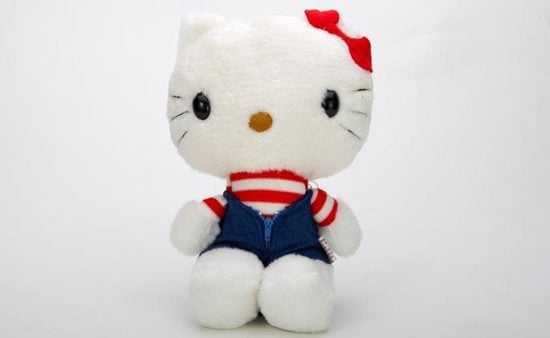Her famous expressionless face has appeared on almost every kind of object—from toys, stationary, toasters, and cosmetics, to pricey jewelry or a hand-made Judith Leiber crystal clutch. Avril Lavigne wrote a controversial song about her; she was the inspiration for a series of sculptures by Tom Sachs and one of Lady Gaga’s outrageous outfits. The cultural phenomenon that is Hello Kitty has reached unbelievable heights since its introduction to the world in 1974, and it doesn’t seem to be slowing down anytime soon. According to the BBC, the Kitty empire is worth $7 billion.
This October, there will be a retrospective of Hello Kitty art, merchandise, and fashion at the Japanese American National Museum and, two weeks later, the first ever Hello Kitty Con will be held at the Museum of Contemporary Art, the Los Angeles Times reports.
This plush toy will be the oldest object on view at the exhibition (1976).
Photo courtesy of Sanrio.
Anthrolopolgist and guest curator for the exhibition, Christine R. Yao (a current visiting professor at Harvard), has spent years studying the phenomenon of Hello Kitty; she is also the author of Pink Globalization: Hello Kitty’s Trek Across the Pacific, published by Duke University Press. “Hello Kitty works and is successful partly because of the blankness of her design,” Yano says. “People see the possibility of a range of expressions. You can give her a guitar, you can put her on stage, you can portray her as is. That blankness gives her an appeal to so many types of people.” Notably, Hello Kitty also has no mouth.
This “blank” expression makes her more than just another manifestation of Japan’s culture of cute, also known as Kawaii. “She doesn’t have this insipid cuteness,” Yano goes on to tell the LA Times. “It’s something clever and creative which contributes to a certain cool factor. For example, take Precious Moments. That’s cute. But there’s nothing cool about Precious Moments. Hello Kitty has the potential to be so many other things.”
Yano also drops this bombshell:
Hello Kitty is not a cat. She is a cartoon character. She is a little girl. She is a friend. But she is not a cat. She’s never depicted on all fours. She walks and sits like a two-legged creature. She does have a pet cat of her own, however, and it’s called Charmmy Kitty.
The curator goes on to fill out more of Hello Kitty’s biographical data:
She lives outside of London. I could go on. A lot of people don’t know the story and a lot don’t care. But it’s interesting because Hello Kitty emerged in the 1970s, when the Japanese and Japanese women were into Britain. They loved the idea of Britain. It represented the quintessential idealized childhood, almost like a white picket fence. So the biography was created exactly for the tastes of that time.
Hello Kitty has always had a special resonance with Asian Americans. When Hello Kitty arrived in the US in 1976, products were mainly sold in Asian communities—Chinatowns, Japantowns, etc. Though she has since gone mainstream, the choice of the Japanese American National Museum as a venue was intended to reconnect Hello Kitty with her original Asian American audience.
“Hello! Exploring the Supercute World of Hello Kitty” opens October 11 at the Japanese American Museum. Hello Kitty Con will run October 30–November 4.
